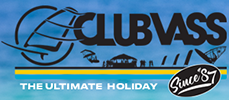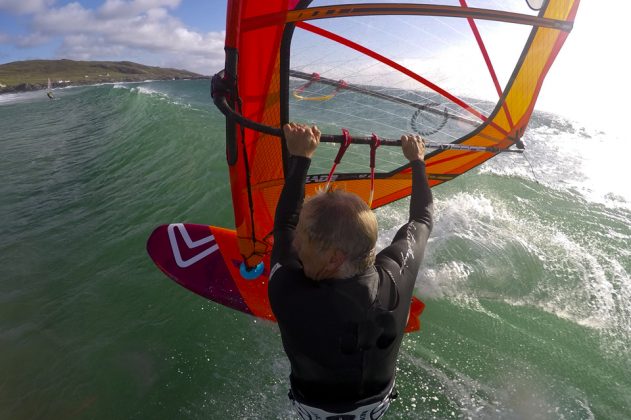Port or Starboard? It matters more than it should.
Words Peter Hart // Photo Hart Photography
Originally published within the November December ’17 edition.
The subject of ‘one-tacki-ness’ raises its head almost daily in my working life. I’m just off the phone to a chap keen to join me in Jericocoara this winter to nail the loop but is hesitating because the wind there is from the wrong side (the right as it happens). He’s done all his previous loop attempts on port. I pointed out that if he can’t loop on either tack, he’ll be better off doing it on the one where he hasn’t suffered a hundred stinging buttock slams and start with a clean sheet. He says he can’t do anything aerial on starboard … but I sense that is because he hasn’t tried much. We’ll see. The port or starboard preference debate is one that throws up more questions than answers. Are you more secure when your stronger arm is forward or back? Are you more dynamic when leading with your stronger or weaker leg? Do we have a dominant nostril that is more sensitive to the wind on one tack etc? Or most tellingly … is it nature or nurture?
Genetically Programmed?
In many fields of human endeavour, kicking, throwing, swinging a golf club, in all but a few ambidextrous cases, we are asymmetrical. Take writing. The Latin word for ‘left’ is ‘sinister.’ In days of yore, children who were left-handed were seen as spawn of the devil. As a result, until relatively recently many ‘leftie’ children were forced to write with their right hand. It conflicted with their hard wiring and was later proven to cause mental and physical problems. King George VI, (he of ‘The King’s Speech’) was one such child and some believe his stutter derived from being forced to write with his right hand.
Windsurfers too refer to their unfavoured tack as ‘the tack of the devil.’ And repeatedly messing up a move you can do with your eyes closed on the other tack, also can drive you crazy … but come on, let’s be real, ‘crazy’ as in ‘a bit frustrated.’
Those who believe in their genetic proclivity to a certain tack will cite those activities like writing, throwing and swinging a tennis racket as proof or an excuse of their ineptitude on their evil tack. But there is a difference. Once you d ecide, probably aged 2, that you’ll throw a ball with your right arm, from that moment on, you will never throw a ball with your left. The poor limb never gets any practice and so looks like a useless string of spaghetti when it tries.There may be a small genetic element to windsurfing one-sidedness. However, as we delve deeper into this scientifically fascinating issue, we discover that the main influence is repetitive drilling. Take the subject at the beginning – jumping.
Jumping
For ‘I hate jumping on port’ read: ‘I haven’t jumped much on port.’ You get good at what you practise. On starboard you’ve taken off 5,324 times; on port to date just twice. For ‘I hate’ substitute: ‘I’m unfamiliar with …’ “But,” you continue, “I always head up and flop on port – it feels so scary …” It’s scary because as yet you haven’t developed the fine in-flight rig handling skills – rig to windward, feathering the sail etc, to control the power; and are reluctant to bear away and soar into catapult territory. Hence you head up deliberately to depower and extend the legs prematurely to find the ground. Repetition is the sole solution. The greatest inhibitor is ego. Are you prepared to look an arse practising a move you can already do once you get home or the wind flips round? Just wear a mask and go for it.
Someone told me that most speed records have been broken by right-handed sailors on starboard tack. I suggested it could have something to do with the fact that most people are right handed and the world record-breaking venues, Sotavento, Tarifa, St Maries-de-la-Mer, Luderitz, are predominantly starboard tack venues.
The regular goofy factor
It is assumed in hardcore surfing circles that you exit the womb either ‘goofy’ (right foot forward) or ‘regular’ (left foot forward). It’s a distinction as defined and unchangeable as your gender (probably a bad example in the current climate).
Really? On your first day of surfing, the instructor gives you a push from behind. You take a step forward to keep balance. “Ah – you’re goofy mate!” the teacher declares because you steadied yourself by moving your ‘dominant’ right leg. But it may have been because the other one got stuck in the sand. No matter. From that moment on you’re branded. Every time you go out you will lead with the right leg and whether it was the right choice or not, the pathway gets routed, it becomes normal and that’s the way you’ll surf forever.
Windsurfing has a simpler algorithm. If on most days you end up in the same country you started out from, then you’ve put in the same time on both tacks. Both arms and both legs have received the same amount of drilling in both directions. Ask people if they feel more comfortable just sailing along with left or right foot forward and most won’t have an answer.
One tack riders
But many wave riders do favour port or starboard conditions – but that’s often a prejudice born out of a youthful apprenticeship in pure surfing. Both Robby Naish and Jason Polakow are goofy surfers. Therefore they prefer left-handed waves and wind from the left. But have you seen them at ‘Jaws’ and Ho’okipa where the wind and waves mostly flow from the right? They’re not half bad – because they’ve got on with it and practiced.
Embrace the difference
But the fact remains that different sides of the body can be stronger and more supple. The theme of the technique feature this month is ‘style.’ So don’t see your differences as weaknesses – but instead exploit them to the point where you develop different styles on either tack.
For example, thanks to being left footed and having a dodgy right knee, I prefer to turn off my left leg. When the left leg leads, I’ll favour long, fast, full rail, front foot turns. On starboard, when it’s the back one, I use it to turn more of the tail and go for snappier, slashier turns – a back foot style you might say.
If you have a particularly strong arm, when it’s the back one, you’ll really feel like sheeting in. So that’s the tack for tight radius gybes, slams, pops or any move where you want to suddenly power up the sail. Perhaps the most influential difference is suppleness around the waist. If you can turn your upper body further one way than the other, you will find moves where hips and shoulders have to separate – switch foot sailing, vertical wave rides etc – much more achievable on your supple side.
My friend Ben had been trying duck tacks for years coming in on his home patch (port tack). But as soon as he turned switch foot, he would just fall into the sail. “Your body doesn’t bend that way Ben!” I cried. That winter he went to Barbados (wind from the other tack) and he cracked them in a week. He could twist fine the other way.
Unless you’re about to enter the PWA where one tack trickery is marked down, don’t bother fighting your natural strengths.
But let’s be truthful, if you are having problems on one tack, you probably haven’t practised enough.
Peter Hart 16th November 2017
PHOTO “Harty on his preferred wave riding tack – but he doesn’t really care…”


